Leeds Castle: The Loveliest Castle in the World?
by Richard Crowhurst
The Domesday Book describes a productive but unremarkable estate.
"Adelold holds Esledes [Leeds] of the bishop. It is assessed at 3
sulungs [about 600 modern acres]. There is land for 12 ploughs.
In demesne [land whose produce was destined for the Lord] are 2
ploughs: and 28 villans [villagers] with 8 bordars [peasants]
have 7 ploughs. There is a church and 18 slaves. There are 2
arpents of vineyard [between a half and two acres] and 8 acres of
meadow, woodland for 20 pigs, and 5 mills of the villans. TRE
[before the Conquest] it was worth £16; when received, the
same; now £20, and yet it renders £25. Earl Leofwine
held it."

Simon Jenkins has called it "an English Udaipur." However, it
is Lord Conway's famous description of "the loveliest castle in
the world" that epitomises Leeds today. So much so that it has
become a marketing tool and something of a cliché through
over-use. Despite this, he was probably right. Leeds' atmosphere
is closer to a country house, yet the visitor is struck by an
atmosphere of solidity in gentile surroundings. There is no
doubting the romance of Leeds. I have attended balls in the
Fairfax hall and visited the grounds in all weathers. It holds a
special place in my heart, as I experienced my first teenage kiss
on the bank of the lake, with the floodlit and snow-covered
castle as the ultimate backdrop. Yet there is a falseness about
Leeds. Despite the site's great age, much of the main building is
a modern restoration; a gothic recreation of a medieval fantasy.
The castle was extensively rebuilt in the 19th and 20th
centuries. The Jacobean house that been built on main island (the
original Norman structure had long been ruined) was demolished in
the 1820s when the Wykeham-Martin family built the current
Gloriette (see below) and house. The American heiress Olive Paget
(later Lady Baillie) brought the castle in 1926, after death
duties forced the Wykeham-Martins to sell, transforming it into a
vision of tasteful luxury with the help of French designer Armand
Rateau. In 1975 Lady Baillie created the Leeds Castle Foundation
to manage the estate after her death and the castle was opened to
the public a year later.
Castle of Six Queens
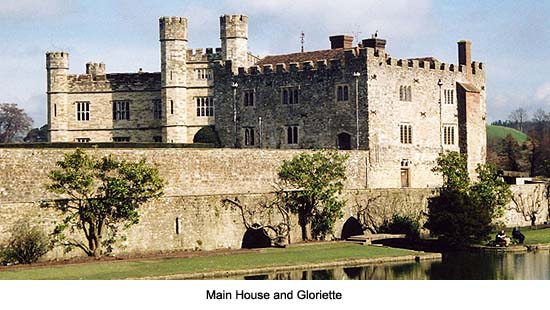
As far back as 857 AD, Esledes Manor had royal links. It was
held by Leed or Ledian, the Chief Minister to the King of Kent,
for the Saxon Royal family. Not only did he leave his name to the
site for posterity, but he also built a wooden structure on two
small islands at a widening of the River Len. It wasn't until the
11th-century motte and bailey built by Hamon de Crevecoeur had
been replaced by a more permanent stone structure that the castle
became a royal palace. In 1278 it was adopted by Edward I and his
Queen, Eleanor of Castile -- who would become the first of six
queens to claim it as her home.
Edward made a number of improvements to the castle, including a
unique Barbican with three separate sections, each complete with
individual drawbridge, gateway and portcullis. He also
constructed a proper set of outer walls and a D-shaped Keep on
the smallest island. This tower became known as the Gloriette in
honour of Queen Eleanor and the name is still used today. Edward
also created the lake, flooding the marshland around the castle
and controlling the river with a complex of dams and sluices.
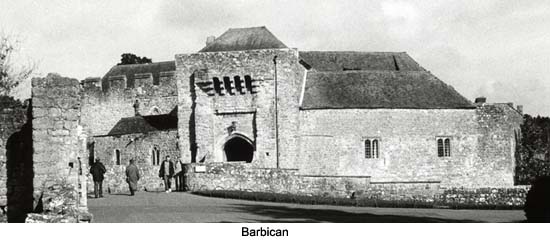
The second queen to claim the castle was Isabella, who
inherited the castle in 1327 after her husband, Edward II, was
murdered. It could be thought of as revenge. Six years earlier
Isabella had arrived at the castle (then held by Edward's
steward) seeking shelter; she was denied admission and her party
was fired upon by archers guarding the castle. Not surprisingly,
Edward II was less than impressed and quickly laid siege to the
castle.
The Castle's most famous owner was Henry VIII, who created a
sumptuous home for his first wife, Catherine of Aragon in 1520.
His main motivation seems to have been to keep her well out of
sight, away from Court, rather than any sense of love! Later
Henry's daughter Elizabeth was imprisoned at leads before her
coronation.
The estate finally passed from royal ownership in 1552 when
Edward VI presented it to Sir Anthony St Ledger. Unlike many
private homes, Leeds survived destruction in the Civil War thanks
to the Culpepper family's support for the Roundheads. This was
the first of many military experiences at the castle, despite its
popular perception as a "Castle of Queens." During the Napoleonic
period it held French and Dutch prisoners of war, while during
the Second World War Leeds was used as a centre to develop and
test secret military technology.
Visiting the Castle
Today the castle is an ideal day out for families. It just
manages to strike a balance between retaining its sense of
history and heritage, and maximising its visitor and corporate
income. This is forgivable as the charitable trust running Leeds
receives no public money.
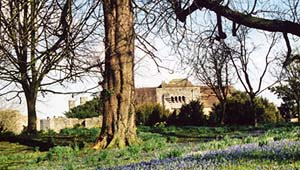 From the ticket
office in the car park, visitors can either catch a land train to
the castle or walk through the Duckery (recommended). The best
time to see the surrounding woodlands is the spring when streams
of daffodils and narcissi and bluebells weave through the ash,
willow and alder trunks. Later in the year rhododendrons and
azaleas present an equally striking display of colour. From the ticket
office in the car park, visitors can either catch a land train to
the castle or walk through the Duckery (recommended). The best
time to see the surrounding woodlands is the spring when streams
of daffodils and narcissi and bluebells weave through the ash,
willow and alder trunks. Later in the year rhododendrons and
azaleas present an equally striking display of colour.
After passing lawns and flowerbeds, the visitor's first view of
the castle comes from beneath an ancient cedar. The ruined
Barbican and Mill are the oldest remaining structures, while the
'modern' house beckons beautifully across its manicured lawn. The
castle contains rooms depicting different periods from history,
and is famous for its collections of furniture, paintings and
tapestries. The rooms are often magically lit by reflections from
the lake. Whatever the season, Leeds always seems to be bathed in
light. A building beside the gatehouse (which was used as a
squash court in the time of Lady Baillie's occupancy) houses a
unique collection of over 100 historic dog collars and other
artefacts. This exhibition is far more interesting than it
sounds.
There's plenty for visitors to see and do beyond the castle. In
addition to exploring the 500 acres of parkland landscaped by
Capability Brown, you can head along the river to the Fairfax
Courtyard. From here you can explore the Culpepper Garden, which
Lady Baillie turned into an archetypal English garden, stuffed
with fragrant blooms for cutting for the house. Below this is the
more recent (1999) Lady Baillie garden. Designed by Christopher
Carter, this Mediterranean-style terrace occupies the original
site of the aviary.
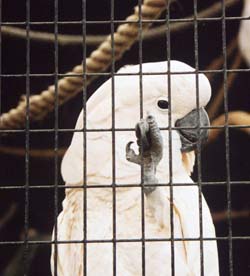 Today's aviary occupies another walled garden above
this and is home to over 100 species. The birds are housed in
state-of-the-art enclosures and the success of the aviary's
breeding programme speaks for their comfort. A more recent
addition to the estates bird population has been the birds of
prey, which can be found near the maze when they are not taking
part in the regular flying displays. Today's aviary occupies another walled garden above
this and is home to over 100 species. The birds are housed in
state-of-the-art enclosures and the success of the aviary's
breeding programme speaks for their comfort. A more recent
addition to the estates bird population has been the birds of
prey, which can be found near the maze when they are not taking
part in the regular flying displays.
Unlike those at other historic houses, the maze at Leeds is
recent -- the 2500 yew trees forming the hedge have only just
reached their full height, having been planted in 1988. The
deceptively tricky maze leads eventually to a rock outcrop, below
which sits an enchanting Grotto, filled with decorative symbols
from different cultures.
A range of special events run throughout the year, including
themed events and festivals, open air concerts, firework
displays, falconry displays and balloon festivals. Activities for
visitors include hawking courses, balloon rides, fishing, golf
and special dining events. There are two well stocked gift shops
and a choice of venue for meals, snacks and drinks.
The castle is well signposted and only minutes, from junction 8
of the M20 motorway, to the east of Maidstone. Leeds Castle is
usually open every day (except Christmas Day), but opening times
can vary for special events, so check before your visit.
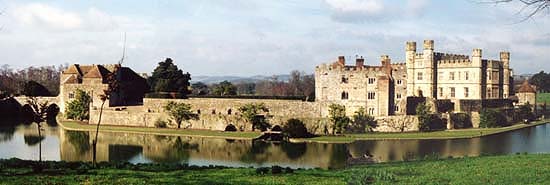
More Information:
We regret that we no longer have the resources to maintain up-to-date links and/or hours and pricing details for the various sites and attractions listed on this website. For more information about the location(s) listed above, please use your favorite search engine or visit Wikipedia.
Richard Crowhurst is a freelance writer and author based in Lincolshire,
England. He writes on many subjects, including history and heritage topics.
More details can be found on his website, http://www.freelance-writer-and-author.co.uk.
Article and photos © 2006 Richard Crowhurst
| 